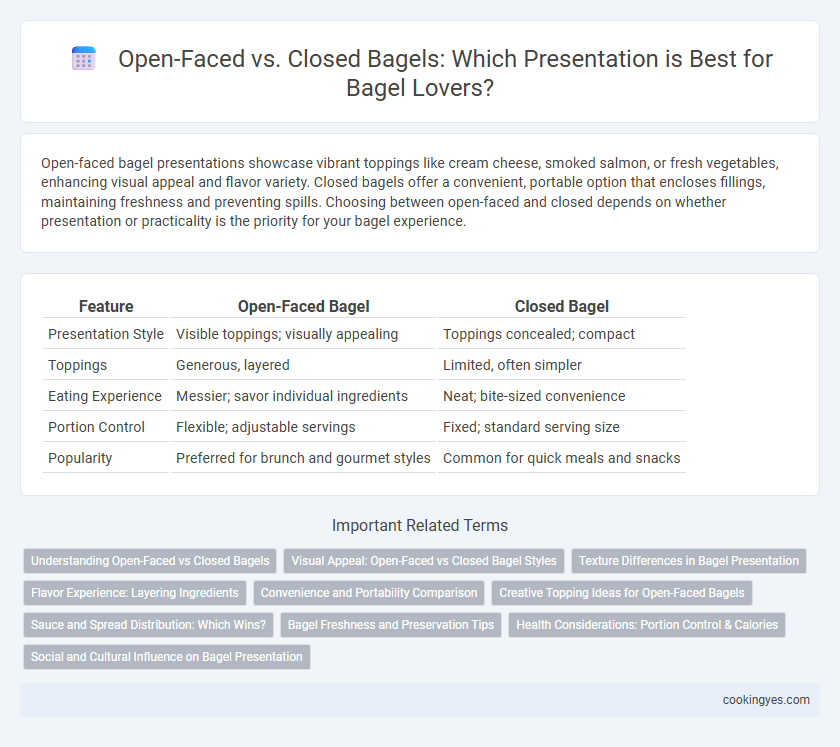Open-faced bagel presentations showcase vibrant toppings like cream cheese, smoked salmon, or fresh vegetables, enhancing visual appeal and flavor variety. Closed bagels offer a convenient, portable option that encloses fillings, maintaining freshness and preventing spills. Choosing between open-faced and closed depends on whether presentation or practicality is the priority for your bagel experience.
Table of Comparison
| Feature | Open-Faced Bagel | Closed Bagel |
|---|---|---|
| Presentation Style | Visible toppings; visually appealing | Toppings concealed; compact |
| Toppings | Generous, layered | Limited, often simpler |
| Eating Experience | Messier; savor individual ingredients | Neat; bite-sized convenience |
| Portion Control | Flexible; adjustable servings | Fixed; standard serving size |
| Popularity | Preferred for brunch and gourmet styles | Common for quick meals and snacks |
Understanding Open-Faced vs Closed Bagels
Open-faced bagels highlight the texture and flavor of toppings by leaving one half exposed, creating a visually appealing and easy-to-eat presentation ideal for ingredients like cream cheese, smoked salmon, or fresh vegetables. Closed bagels sandwich fillings between two rounds of dough, offering portability and structural integrity, which is perfect for heartier ingredients such as deli meats, cheeses, and egg-based fillings. Understanding the differences in presentation helps optimize the eating experience and presentation style based on the type of bagel and desired consumption method.
Visual Appeal: Open-Faced vs Closed Bagel Styles
Open-faced bagels showcase colorful toppings like cream cheese, smoked salmon, and fresh vegetables, enhancing visual appeal through vibrant, layered presentation. Closed bagel styles offer a neat, compact look ideal for handheld consumption, emphasizing symmetry and volume but limiting visibility of fillings. Choosing between open-faced and closed styles depends on desired aesthetics and eating convenience, with open-faced designs often preferred for attractive food displays.
Texture Differences in Bagel Presentation
Open-faced bagels highlight the contrast between the soft, chewy interior and the crispy, toasted edges, offering a textural variety with each bite. Closed, or sandwich-style bagels, envelop fillings that infuse moisture, resulting in a denser, more uniform texture throughout. The choice between open-faced and closed bagel presentation significantly impacts the tactile experience, balancing crunch and softness differently.
Flavor Experience: Layering Ingredients
Open-faced bagels highlight the flavor experience by showcasing each ingredient distinctly, allowing the taste of cream cheese, smoked salmon, and fresh vegetables to stand out individually. Closed bagels blend ingredients within the bread, creating a harmonious but less distinct flavor profile where textures meld together. Layering ingredients on an open-faced bagel enhances visual appeal and enables precise control over each bite's taste intensity.
Convenience and Portability Comparison
Open-faced bagels offer convenience with easy visibility of toppings and quick access for eating, but lack portability due to exposed ingredients prone to falling. Closed bagels provide superior portability by encasing fillings securely, making them ideal for on-the-go consumption while maintaining freshness. Choosing between open-faced and closed presentations depends on balancing ease of access with the need for portable, mess-free enjoyment.
Creative Topping Ideas for Open-Faced Bagels
Open-faced bagels invite creativity with toppings like whipped cream cheese, smoked salmon, capers, and thinly sliced red onions that showcase vibrant colors and textures. Fresh herbs such as dill or chives, combined with avocado slices or tomato, enhance both flavor and visual appeal. This presentation style allows each layer to be visible, making it ideal for artistic arrangements and gourmet combinations.
Sauce and Spread Distribution: Which Wins?
Open-faced bagels showcase sauce and spread with even distribution, allowing flavors to blend seamlessly on each bite. Closed bagels, while convenient, often trap spreads inside, leading to inconsistent taste and uneven sauce coverage. For optimal flavor balance and visual appeal, open-faced presentations generally offer superior sauce and spread distribution.
Bagel Freshness and Preservation Tips
Open-faced bagels expose the soft interior, enhancing freshness perception and allowing toppings to remain crisp, but they may dry out faster if not consumed promptly. Closed bagels, with toppings enclosed between two halves, better preserve moisture and extend freshness by limiting air exposure. Storing bagels in airtight containers at room temperature or freezing them in sealed bags can further maintain texture and flavor for several days.
Health Considerations: Portion Control & Calories
Open-faced bagels offer better portion control by limiting toppings to one half, reducing overall calorie intake compared to closed sandwiches. Closed bagels typically contain double the amount of fillings, significantly increasing fat and carbohydrate content. Choosing open-faced presentation supports mindful eating habits and aids in managing daily caloric consumption.
Social and Cultural Influence on Bagel Presentation
Open-faced bagels hold cultural significance in Jewish and New York deli traditions, symbolizing communal dining and casual sharing. Closed bagels, often stuffed or made into sandwiches, reflect evolving social preferences toward portability and convenience in fast-paced urban lifestyles. These presentation styles reveal how bagel consumption adapts to cultural identity and modern social dynamics.
Open-Faced vs Closed for Bagel Presentation Infographic

 cookingyes.com
cookingyes.com